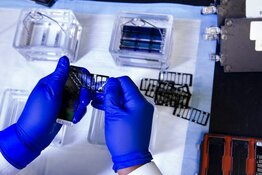The Life Sciences Report: Hugh, could you tell me why you formed Roadmap Capital?
Hugh Cleland: I wanted to build a team with deep domain expertise in healthcare/biotech and fundamental technologies—two areas where Canada's investment community has not traditionally focused. There is no shortage of innovation in Canada, but the long bull market and bubble in the resource sector sucked enormous amounts of capital and expertise out of those sectors, leaving a trail of undercapitalized and undervalued assets in its wake, particularly in the private and micro-cap areas of healthcare and technology. I have assembled a team—we are now up to 8 people—that can help me scrounge through the bear market debris left behind in those two sectors.
TLSR: Hugh, it seems you're on your way. You're raising money now. My understanding is that you plan to close your first fund on June 30, 2014. How much in assets will you have under management in this fund? What is your goal?
HC: Right now, in Roadmap Capital, we're just under $50 million ($50M) in total assets. By June 30, we expect that to be in the $75–100M range—hopefully higher.
TLSR: Can you manage $100M efficiently in micro-cap stocks?
HC: Absolutely. But we're not just investing in micro-cap stocks. We're putting a lot of new capital to work in private companies, both those we expect to stay private for the life of the investment, as well as those we expect to bring public within the next six to 24 months. In fact, we will go so far as to be involved in company formation, and also in helping companies go public.
TLSR: Why invest primarily in Canadian companies? If you were exclusively a resource investor, and looking for deep value as well as growth, this is understandable, but in the life sciences sector, where the goal is huge growth, why limit yourself to Canadian stocks? Is it about tax advantages? National pride?
HC: I should point out that the new fund has made investments in the U.S. already, and will continue to do so. But we are focusing primarily in Canada. Frankly, it's about where we see the best opportunities and risk/reward ratio. There's no shortage of innovation in Canada, but the long, drawn-out bear market that the Canadian tech and healthcare sectors went through for much of the last decade has left many interesting companies valued at levels far below what is available in other countries. To give you an example, we're putting money into a company with a $2.5M pre-money valuation. Comparable companies in the States would be valued in the $30–40M pre-money range currently. And we have invested a small amount of money into a private stem cell company called Hemostemix. It is raising money at a $25M pre-money valuation, when its best public comparables in the U.S. trade at valuations in the $200—400M range. It comes down to where we see the best valuation opportunities and risk/reward for our investors right now.
TLSR: Stephen, will you do continuing diligence on current portfolio companies as well as diligence on proposed new additions to your portfolio?
Stephen Ireland: In terms of priority, the focus will be on new diligence activities for companies that we've identified as potential investment opportunities. But there will be ongoing diligence obligations for companies already in the portfolio. We want to make sure that milestones in business plans are met, intellectual property portfolios maintained and clinical trials executed to best affect company value. Performing diligence on new companies and companies already in our portfolio is part and parcel of our skill set collectively.
TLSR: Stephen, you've been in the pharma and biotech industries for more than 25 years, including serving as former senior vice president for business development at North Carolina-based TransTech Pharma Inc., a private biotech company with a lot of strategic partners in drug development. You understand what goes on in a private company. After you sign a confidential disclosure agreement with a private group, do you feel like you know what to look for in a company that does not make quarterly public filings?
SI: Absolutely. The very early, basic discovery-stage science varies from company to company and target to target, and is often shaped by personalities of the founding scientific staff. Once a compound moves into animal trials and, more important, into human trials, there are certain studies regulatory agencies expect a biotech to do. Based on my experience, I have a good idea of the questions to ask to access data at each stage of development, and how to analyze those data. I'm also very familiar with deals biotech companies do with academics, contract research organizations, contract manufacturing organizations and licensing partners, which enables me to evaluate their business obligations and opportunities.
TLSR: Stephen, you've been deeply involved in hands-on negotiations between companies big and small. My understanding is that you have led the charge on deals potentially worth in excess of $3 billion ($3B) with Pfizer Inc. (PFE:NYSE) and Forest Laboratories Inc. (FRX:NYSE). Is it fair to say that you might also be involved in business development as far as negotiating between your portfolio companies and the companies you've had experience with in the past?
SI: I hope I'm able to facilitate that. I believe my experience adds value to the various processes companies undertake to either sell their assets in a merger-and-acquisition (M&A)-type transaction, participate in outlicensing activities or partner for skill sets that they may not have.
TLSR: Hugh, let's talk about Cynapsus Therapeutics Inc. (CYNAF:OTCQX; CTH:TSX.V).
HC: It's been fun. We are up with Cynapsus 280% in Canadian dollars since I mentioned the company in my June 2013 interview with The Life Science Report. It was at CA$0.34/share then, and it's still just a micro cap, with a CA$45M (basic) market cap today. We continue to be very excited about the company and where it's going. Of course, these situations are not without risk. But Cynapsus appears to have a very strong risk/reward benefit. I would point to the work of senior biotechnology analyst Jason Napodano of Zacks Investment Research on this stock. He initiated on the stock last June when it was $0.30/share, made it a top pick for 2014 when it was still below $0.40/share, and reiterated that it was one of his best ideas just last month. It was gratifying to see someone with his experience and skill come to the same conclusion that Roadmap Capital has.
TLSR: Cynapsus successfully completed its phase 1b trial with APL-130277 (sublingual thin film strip formulation of apomorphine). The product demonstrated plasma levels of apomorphine that are consistent with those obtained from subcutaneous injections of Apokyn (apomorphine hydrochloride injection; Mylan Inc. [MYL:NASDAQ]). This product will ultimately have to show efficacy in actual Parkinson's disease (PD) patients who are experiencing "off episodes" (hypomobility or "frozen" states), won't it? What is the next catalyst?
SI: The company will finish dosing the 25mg strength of APL-130277, then will embark on APL-130277 efficacy studies, the first of which will be in an Apokyn-naïve patient population, I believe.
" Positive clinical data will make Cynapsus Therapeutics Inc.'s APL-130277 a very attractive asset for specialty pharma or large pharma."
Cynapsus has development options from a regulatory perspective. It can go down a pure bioequivalence pathway and show the sublingual strip formulation has equivalent pharmacokinetics (PK: absorption, distribution, metabolism and excretion) as subcutaneous Apokyn injection, or it can go after superior safety, along with efficacy. Obviously, if Cynapsus can demonstrate superior safety and efficacy, it will put the product in an even stronger position in a market that is already forecast to be in excess of $700M per year.
TLSR: Do you expect this company to go out on a trade sale in a year or two, or do you expect to see this product commercialized with a partner while it's partly under Cynapsus' control?
SI: Positive clinical data will make APL-130277 a very attractive asset for specialty pharma or large pharma, and I expect Cynapsus will be targeted for M&A activity before it gets a chance to commercialize the product.
TLSR: A new drug application (NDA) submission to the U.S. Food and Drug Administration (FDA) is anticipated in 2016. Will we see a launch of this product in 2016?
SI: If things proceed as we expect, yes. It depends on when exactly the submission goes in.
"There's no shortage of innovation in Canada."—Hugh Cleland
The data package will be fairly straightforward because apomorphine is a known molecule, and its mechanism of action is well understood. It's just the route of delivery that's different. The company has compelling PK data from its phase 1 study, suggesting plasma levels are proportional with dose, and the delivery method achieves levels in an important range between the minimum efficacious dose and the minimum dose associated with adverse events. PK profiles I've seen suggest that not only does the product get into this range, but it also maintains plasma levels longer. This could mean its activity in patients may have a more sustained duration, which is certainly not the case with the subcutaneous version of the molecule. This all points to a favorable review from the agency, and I think it's quite possible APL-130277 could launch in 2016.
TLSR: One of the great selling points of Cynapsus' sublingual strip is that when a patient is having an off episode, rather than trying to handle an injection, the patient may be able to get the drug under the tongue. Therefore, families might be less afraid to leave a patient alone for a while. Do you imagine this is an issue the agency will take into consideration when APL-130277 is up for approval?
SI: Yes. These patients suffer poor quality of life because of these off episodes, and have difficulty self-administering injections. We need therapies that offer these patients a higher quality of life and better ease of use, and I think APL-130277 sublingual strips hold promise in both of these regards.
TLSR: Hugh, do you see Cynapsus shares getting another double or triple from current levels?
HC: My view lines up with Jason Napodano's, and he sees a lot more potential than just a double or triple if this drug gets approved. We both like the risk/reward at these levels for a company that has a drug candidate with peak sales potential somewhere in the $600–900M range.
TLSR: What's the next one you wanted to talk about?
HC: Let's talk about BELLUS Health Inc. (BLU:TSX; BLUSF:OTCPK). BELLUS presented to our advisory board back in May 2013 and came out as one of the favorites. It was a particular favorite of advisory board member Harlan Waksal, who cofounded Imclone Systems Inc., which sold to Eli Lilly and Co. (LLY:NYSE) for $6.5B on the strength of its monoclonal antibody Erbitux (cetuximab; for head-and-neck cancer and metastatic colorectal cancer). Stephen spent a few months digging in. By the time he was finished with his deep due diligence, he was as big a fan.
TLSR: What grabbed your attention about BELLUS?
HC: One thing that really grabbed me was the enormous valuation disparity that has existed for a variety of very unusual circumstances. With BELLUS, you have a fully funded orphan drug candidate called Kiacta (eprodisate disodium, an orally available small molecule) that is in a phase 3 trial reasonably close to the end of enrollment. The drug is being tested in a lethal disease called AA amyloidosis, which affects 50,000 people in the U.S., Europe and Japan.
The company indicates expected peak sales of around US$500M, but our research suggests we could see peak sales significantly higher than that, perhaps as high as US$1B. Yet somehow, the company is still trading at a fully diluted enterprise value of less than US$35M. I have never seen a fully funded phase 3 asset with such a big market opportunity trade at such a ludicrously low valuation.
"BELLUS Health Inc. presented to our advisory board and came out as one of the favorites."
If you look at publicly traded orphan drug comparables in the U.S., it gives you an idea of the enormous potential upside for this stock. For example, Raptor Pharmaceutical Corp. (RPTP:NASDAQ) is an orphan drug company that successfully completed its phase 3 trial, and is now marketing its drug. Canaccord Genuity's Ritu Baral estimates peak sales of US$160M in the U.S. and the European Union; Raptor's market cap is now US$700M. Sarepta Therapeutics Inc. (SRPT:NASDAQ) is another orphan drug company, and is at a more comparable stage of development to BELLUS in that Sarepta does not yet have FDA approval, and is in the midst of studies that could lead to that approval. Sarepta's enterprise value is currently more than US$800M.
TLSR: The final data collection date for BELLUS' phase 3 trial is September 2016, according to ClinicalTrials.gov, but the company says enrollment of this 230-patient trial will complete earlier than originally anticipated. When could we see a launch of Kiacta?
SI: The study has enrolled faster than anticipated, and the company should complete enrollment by June. BELLUS will follow patients until at least 120 of them have had an event defined as a worsening of renal function. That's the part that takes the time. It will probably be early 2016 before we'll get a read-out. If the data are compelling and come out early enough in 2016, it's possible the company could submit for approval the same year. I think it's quite likely we'll see approval and product launch in 2017.
I want to tie these timeframes into our "valuation gap" investment thesis. The thesis starts with the enormous valuation disparity: an enterprise value (EV) of US$35M for BELLUS compared to, for example, an EV of US$800M for Sarepta.
The fact that Kiacta is fully funded to the end of phase 3 means investors won't get ambushed by a financing. The fact that the phase 3 data doesn't read out until early 2016 (which would often be seen as a bad thing) means that the stock can gradually move up, filling the enormous valuation gap with minimal event risk for almost a full two years before the binary event occurs.
"We want to make sure that milestones in business plans are met, intellectual property portfolios maintained and clinical trials executed to best affect company value."—Stephen Ireland
We also know that speculation as to the outcomes of phase 3 trials typically begins six months before a trial reads out; this would mean the '"read-out speculation" should begin in the summer of 2015. In the meantime—in the one and a quarter years between now and then—we fully expect the stock to be able to reach a still-cheap US$200M valuation, or $3/share. We think the fact it can make that move even before the read-out speculation begins, with no financing risk and no event risk makes BELLUS a particularly compelling investment. Our money is where our mouth is: The company is currently among the largest positions in the two Roadmap funds that are actively making investments.
TLSR: Which company did you want to speak about next, Hugh?
HC: I would like to touch on IntelGenx Corp. (IGXT:OTCQX; IGX:TSX.V). We've had more than 10% ownership in this company for quite a while; it wasn't until the company did a financing in December 2013 that our equity went below 10%. We're still very enthusiastic about the future for IntelGenx.
The company utilizes the FDA's 505(b)2 pathway to develop already-approved drugs in new ways. There's less efficacy risk and no toxicity risk. In fact, this is what Cynapsus is doing with apomorphine.
"Basic discovery-stage science varies from company to company and target to target, and is often shaped by personalities of the founding scientific staff."—Stephen Ireland
Recent developments suggest that IntelGenx is going to become a sublingual strip company, and its relationship with Par Pharmaceutical Companies Inc. (private) has become a company maker. It has a codevelopment agreement with Par on a generic version of Suboxone (buprenorphine + naloxone sublingual film; Reckitt Benckiser Pharmaceuticals Inc. [RBGPY:OTCPK]) for opiate addiction, for which it filed an abbreviated new drug application last July. In mid-January, the company announced it is working with Par on two more projects. For me, this announcement is a sign of something very special happening at IntelGenx. I believe this relationship gives IntelGenx upside somewhere into the US$3–10 per share range over the next two to three years, depending on what the other assets are. There are other drugs in the company's pipeline, and we're expecting another NDA to be filed this year. The two publicly traded U.S. comps, BioDelivery Sciences International Inc. (BDSI:NASDAQ) and Supernus Pharmaceuticals Inc. (SUPN:NASDAQ), suggest there is a valuation gap to be filled here, too.
TLSR: IntelGenx shares have doubled over the past year. Is this on the strength of revenue from its approved product, Forfivo (bupropion HCL extended-release; a dose reformulation of GlaxoSmithKline's [GSK:NYSE] Wellbutrin XL)?
HC: I don't believe that Forfivo was the driver; I think it was the Par relationship, as well as the NDA filing for the rizatriptan sublingual film for migraine. We're expecting the migraine drug to be approved by the FDA in the next few months, and that will be another catalyst.
Frankly, Forfivo is a product that I'm encouraging the company to sell. I think IntelGenx can put the proceeds of that sale to better use in other areas, but I'm not sure the company wants to do that. It is nice to have a cash-generating asset within the company, that's for sure. But I think if IntelGenx can get a lump sum for that asset above CA$10M, maybe up to CA$20M, it would be cash the company could put toward good uses.
TLSR: The buyer of Forfivo would have the overhang of that Paragraph IV Certification Letter IntelGenx received last August. The company says it intends to enforce its intellectual property rights and fight this thing. So it may be an inopportune time to attempt to shed this product.
HC: It very well may wait until after that's resolved. But either way, Forfivo is no longer a driver for IntelGenx.
TLSR: So the drivers at IntelGenx are the rizatriptan sublingual film strip for migraine and the opiate-addiction product. Is that right?
HC: Correct. IntelGenx does, however, have a pipeline totaling about seven drugs, as well as the two additional projects with Par Pharmaceutical. The pipeline is deep.
TLSR: Could we hear about another name?
SI: I'd like to mention Immunovaccine Inc. (IMV:TSX.V). I'm a fan of immunotherapies for cancer, and think some cancers will ultimately be cured using some form of targeted immunotherapy. There are significant hurdles to overcome, including 1) how to defeat the defense mechanisms that tumors have developed to evade innate immune responses, 2) how to mount a strong CD8+ T-cell response in the tumor microenvironment, and 3) how to engender an adaptive, durable and sustained T-cell memory for the particular antigen.
"Successful phase 2 results are often the largest value-creating events in the drug development cycle."—Hugh Cleland
Immunovaccine has a novel technology that addresses these issues in its DepoVax platform. The DepoVax vaccine is an antigen-plus-adjuvant combination that's encapsulated in a liposome, which is then surrounded by an oil emulsion. The result is a depot release leading to sustained and specific immune response to the therapy.
In its phase 1 study, Immunovaccine has been able to demonstrate strong CD4+ and CD8+ T-cell responses and, in particular, specific responses to survivin, a well-validated negative regulator of apoptosis in many types of cancer. The company has good dose response data from its phase 1 study, and is preparing to launch two phase 2 studies with its DPX-Survivac therapy, one in ovarian cancer and one in glioblastoma.
TLSR: Stephen, are we looking at a very long development track with these vaccines?
SI: It's certainly longer than those faced by other companies that we've discussed. Ovarian cancer is an orphan indication, and glioblastoma has very few therapeutic regimens that work. Intervention in each is typically surgical. Regulators are motivated to consider fast-track approval status for any company that can show compelling clinical data in these indications, and I think that's what Immunovaccine is looking to do.
HC: Let me point out that there will be significant value-creation milestones along the way. Successful phase 2 results are often the largest value-creating events in the drug development cycle.
SI: I agree with Hugh. Positive phase 2 proof-of-concept data can be a tremendous value driver for a biotech company, and often is the trigger for M&A-type discussions with large pharma partners.
HC: That's a good segue to iCo Therapeutics (ICO:CVE), in that iCo is getting fairly close to the readout of its phase 2 data for diabetic macular edema (DME).
We participated in a save-the-company insider round of CA$0.20 units a year and a half ago. We made a very good return on that investment, and we've continued to be big fans of the company for a variety of reasons. The company came through our advisory board process with flying colors.
TLSR: I understand that the company's phase 2 iDEAL trial with iCo-007, an antisense oligonucleotide, is supposed to read out at the end of April. This is not a company-sponsored trial but rather an investigator-sponsored trial with 208 patients; randomized, but open label. I wonder how much stock you can put into those data when you see them?
SI: The trial has hard primary and secondary endpoints, the change in visual acuity and reduction in retinal thickening, respectively. Both are measured from baseline to month eight. If positive, the data will be robust. The company's compound offers some advantages in terms of durability of effect over what's currently on the market, potentially affording iCo a competitive edge. This study will indicate the magnitude of effect iCo-007 has on these endpoints.
I don't foresee any negative consequences associated with iDEAL being investigator-sponsored. The study is being run at a top-level institution by expert clinicians in DME.
TLSR: This compound will certainly need a pivotal trial, won't it?
SI: iDEAL has been rigorously designed and well executed, and the data could point to compelling efficacy. It's hard to anticipate how regulators will react to the data until after it's submitted. However, it is likely iCo-007 will require a pivotal study for approval in DME.
HC: I'd like to touch quickly on two more companies before we finish up. Tekmira Pharmaceuticals Inc. (TKM:TSX; TKMR:NASDAQ) was one that I highlighted back on June 27, 2013, when it was $4.76. It's been a spectacular rocket ride. We think it will continue to be successful for investors. The two best U.S. comparables in Tekmira's space are Alnylam Pharmaceuticals Inc. (ALNY:NASDAQ) and Arrowhead Research Inc. (ARWR:NASDAQ). These comps suggest Tekmira has plenty of valuation upside, even without further fundamental developments.
We became involved with CNS Response Inc. (CNSO:OTCMKTS) a while ago, and although it is already a winner for us, we expect much more. The company's technology combines EEG brain scan data with a large database of prescription outcomes to improve the ability of physicians to prescribe the "right" medication for psychiatric disorders, without going through what is often a lengthy or unsuccessful trial-and-error process. The company website actually does a good job of describing what they do and why what they do is important.
The first big market that CNS Repsonse can address is post-traumatic stress disorder (PTSD). The Walter Reed National Military Medical Center is now leading a 2,000-soldier, multisite, randomized, controlled trial of the PEER system, focused on depression. If successful, this study should lead to widespread adoption of the CNS PEER system by the U.S. military, which seeks to reduce the horrifically high PTSD-linked suicide rate. Results are expected in Q2/14. If the trial is successful, CNS should trade at multiples of its current price.
TLSR: Thank you, Hugh and Stephen. I enjoyed it.
HC: Thank you very much.
SI: Thank you.
Hugh Cleland, BA, CFA, is cofounder, CEO, president, CIO and principal portfolio manager of the Roadmap Innovation Fund I and the Roadmap Trust. He is also portfolio manager, through a subadvisory contract between Roadmap Capital and BluMont Capital, of the BluMont Innovation PE Strategy Fund. Cleland earned a bachelor's degree with honors from Harvard University, and his CFA designation in 2001. After graduating from Harvard, Cleland worked in the research department at Midland Walwyn Capital (subsequently Merrill Lynch Canada) as research associate to the senior telecommunications services analyst. From March 1998 to March 2001, Cleland worked at Interward Capital Corp., first as an analyst, and later as associate portfolio manager, specializing in technology equities. He was founding portfolio manager at Northern Rivers Capital Management, where he worked from May 2001 until Northern Rivers was acquired by BluMont Capital in February 2010. Together with Riadh Zine, he cofounded Roadmap Capital Inc. in August 2013.
Stephen Ireland, healthcare specialist and a principal with Roadmap Capital Inc., has been involved in the pharmaceutical, specialty pharmaceutical and biotech industries for more than 25 years. He was the former senior vice-president business development at TransTech Pharma. Ireland managed transactions in 2006 and 2010 with Pfizer and Forest Laboratories, respectively, valued in excess of $2B. Ireland received his bachelor's degree in biological sciences with honors from Brock University, Ontario, Canada.
Read what other experts are saying about:
Want to read more Life Sciences Report interviews like this? Sign up for our free e-newsletter, and you'll learn when new articles have been published. To see a list of recent interviews with industry analysts and commentators, visit our Interviews page.
DISCLOSURE:
1) George S. Mack conducted this interview for The Life Sciences Report and provides services to The Life Sciences Report as an independent contractor. He or his family own shares of the following companies mentioned in this interview: None.
2) The following companies mentioned in the interview are sponsors of The Life Sciences Report: Cynapsus Therapeutics Inc., BELLUS Health Inc. Streetwise Reports does not accept stock in exchange for its services or as sponsorship payment.
3) Hugh Cleland: I own, or my family owns, shares of the following companies mentioned in this interview: BELLUS Health Inc., IntelGenx Corp. I personally am, or my family is, paid by the following companies mentioned in this interview: None. My company has a financial relationship with the following companies mentioned in this interview: None. I was not paid by Streetwise Reports for participating in this interview. Comments and opinions expressed are my own comments and opinions. I had the opportunity to review the interview for accuracy as of the date of the interview and am responsible for the content of the interview.
4) Stephen Ireland: I own, or my family owns, shares of the following companies mentioned in this interview: None. I personally am, or my family is, paid by the following companies mentioned in this interview: None. My company has a financial relationship with the following companies mentioned in this interview: None. I was not paid by Streetwise Reports for participating in this interview. Comments and opinions expressed are my own comments and opinions. I had the opportunity to review the interview for accuracy as of the date of the interview and am responsible for the content of the interview.
5) Interviews are edited for clarity. Streetwise Reports does not make editorial comments or change experts' statements without their consent.
6) The interview does not constitute investment advice. Each reader is encouraged to consult with his or her individual financial professional and any action a reader takes as a result of information presented here is his or her own responsibility. By opening this page, each reader accepts and agrees to Streetwise Reports' terms of use and full legal disclaimer.
7) From time to time, Streetwise Reports LLC and its directors, officers, employees or members of their families, as well as persons interviewed for articles and interviews on the site, may have a long or short position in securities mentioned and may make purchases and/or sales of those securities in the open market or otherwise.












































